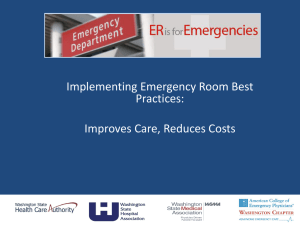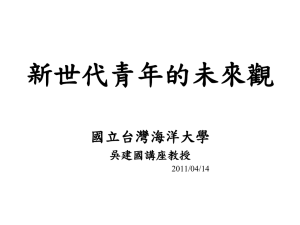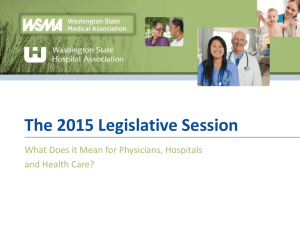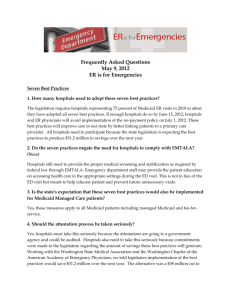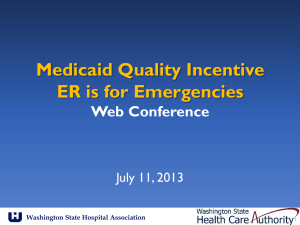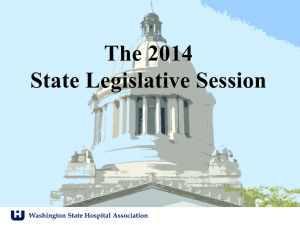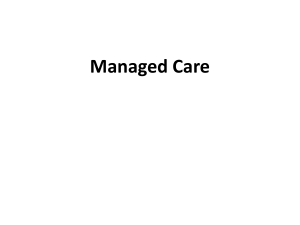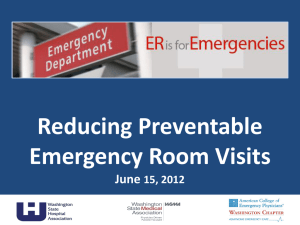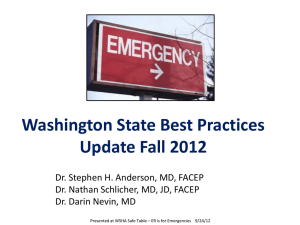Best Practices Slides - Washington State Hospital Association
advertisement
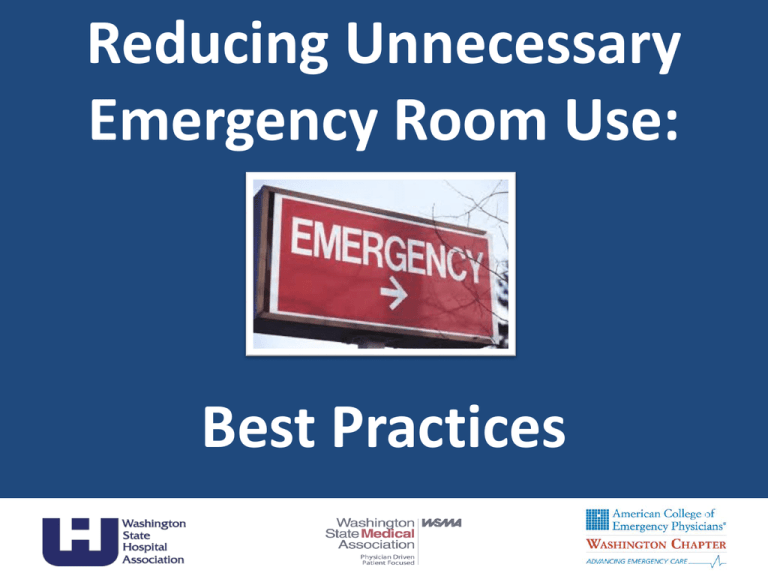
Reducing Unnecessary Emergency Room Use: Best Practices 1 WSHA Presenters Scott Bond Claudia Sanders Chief Executive Officer Senior VP, Policy Development Carol Wagner Barbara Gorham Senior VP, Patient Safety Policy Director, Access 2 Partner Presenters Washington State Medical Association Tim Layton Washington Chapter American College of Emergency Physicians Dr. Stephen Anderson Dr. Nathan Schlicher 3 Webcast Objectives • • • • • • • Overview Emergency room overuse: a significant issue History The seven best practices A fast timeline! How we can help Questions and comments 4 An Opportunity Redirecting Care to the Most Appropriate Setting 5 Health Care is Changing • Work with the state and partner physicians • To be sustainable in the long term: – Adequate payment – Cost reduction 6 Partnering for Change • Washington State Hospital Association • Washington State Medical Association • Washington Chapter of the American College of Emergency Physicians 7 Emergency Room Overuse: It Is a Problem 8 Medicaid ER Use Is High In the past year: • About 40% of Medicaid clients visited an ER • About 18% of people with private insurance visited an ER Contributing factors: Lack of primary care Substance abuse Mental health 9 One client: Frequent Users All clients: Focus on Patients Requiring Coordination (PRC) Enrollees per county . 009 .005 0 Is the ER the new medical home of the 21st century? Legislative Solutions 13 State Approaches to Curbing ER Use When Original proposal Revised proposal Current policy What 3-visit limit on unnecessary use No-payment for unnecessary visits Adoption of best practices Impact Cuts payments to providers Status Won lawsuit; policy abandoned Cuts payment to providers Delayed by the Governor just prior to implementation Passed in latest state budget Improves care delivery and reliance on ER as source of care 14 Voices Heard • Contact with legislators • Contact with media • Discussion of legal barriers 15 Savings without Penalties Provides the state with savings by asking hospitals, and their physician partners, to implement the right systems for care 16 If Unsuccessful Revert to the no-payment policy. $38 million in annual cuts! 17 Ultimate Goal: Reduce Trend Current projected trend Changing the trend 18 Partners Will Be There • Emergency room physicians will be pushing for hospital adoption 19 The Seven Best Practices 20 A) Electronic Health Information Goal: Exchange patient information among Emergency Departments • Identify frequent users • Get access to treatment plans • Use in providing care • Exceptions for CAHs with financial burden 21 How to Accomplish Emergency Department Information Exchange (EDIE) • 30 hospitals in Washington already using • EDIE can: – Notify ED physician of frequency of ED visits and summary of ED discharges for past 12 months – Share guidelines for patient with other hospitals – Load patient’s treatment plan, so ED physicians can view • Costs: – Depends on number of ED visits – $2,000 to $5,000 setup plus $1,200 to $30,000 a year 22 B) Patient Education Goal: Help patients understand and use appropriate sources of care • Active distribution of educational materials • WSHA/WSMA/ACEP brochure • Discharge instructions 23 How to Accomplish • Use WSHA brochures or customize for your hospital • Decide when and how to distribute – Upon arrival, at discharge, or display prominently • Incorporate into electronic discharge instructions, if warranted • Train ED physicians on educating patients about the appropriate care setting – Presentation disseminated by ACEP 24 C) Patients Requiring Coordination (PRC) Information Goal: Ensure hospitals know when they are treating a PRC patient and treat accordingly • PRC clients = frequent ER users, often narcotic seekers • Receive and use client list • Identify patients on arrival • Develop and coordinate case management programs • Use care plans 25 How to Accomplish • Identify who at hospital receives and disseminates information on PRC clients • Use information in EDIE to alert physicians – Frequent user = someone who has used ER five or more times in the past 12 months • Make PRC care plans available to ER physicians • Best success with case management in ER 26 D) PRC Client Care Plans Goal: Assist PRC clients with their care plans • Contact the primary care provider when PRC client visits the ER • Efforts to make an appointment with the primary care provider within 72 hours when appropriate • If no appointment required, notify primary care provider that a visit occurred • Relay barriers to care to Health Care Authority 27 How to Accomplish • Develop system to call primary care providers during and after PRC visit to emergency room • Develop system to relay issues regarding access to primary care to the HCA 28 E) Narcotic Guidelines Goal: Reduce drug-seeking and drug-dispensing to frequent ER users • Implement ACEP guidelines for prescribing and monitoring of narcotics • Direct patients to better resources • Track data and follow-up with providers who excessively prescribe 29 How to Accomplish • Change hospital policy to conform with ACEP guidelines: – – – – Prohibit long-acting opioids and discourage injections Screen patients for substance abuse Refer patients suspected of Rx abuse to treatment Other • Train ER prescribers in narcotic guidelines • Consider joining “oxy-free” movement • When guidelines implemented, hospitals have seen significant drop in visits 30 F) Prescription Monitoring Goal: Ensure coordination of prescription drug prescribing practices • Enroll providers in Prescription Monitoring Program: electronic online database with data on patients prescribed controlled substances • Target enrollment for ER providers : – 75% by June 15, 2012 – 90% by December 31, 2012 31 How to Accomplish • WSMA and WA/ACEP encourage members to sign up • Educate and encourage medical staff to enroll • Hospitals track enrollment of ER prescribers to report to HCA by June 15 and December 31, 2012 32 G) Use of Feedback Information Goal: Review reports, ensure interventions are working • Report specified information to Health Care Authority • Designate ER leader and quality manager to receive, review, and act on utilization management reports • Involve executive-level leadership 33 ED WORK GROUP WSHA, WSMA, WA/ACEP and the state Health Care Authority will develop and monitor metrics on performance by hospital and by physician – Example measures: • • • • Rate of unnecessary visits Rate of visits by PRC clients Rate of PRC clients with treatment plans Rate of prescriptions with long-acting opioids 34 How to Accomplish • EDIE produces standard reports • Hospitals may be called on to gather and report other easily available data • Feedback reports will be made public 35 Provider Training • Hospitals must ensure providers are trained • WA/ACEP will provide template: – Training providers on how to educate patients on choosing the appropriate care setting – Training providers on guidelines for narcotic prescribing and monitoring 36 Quality Assurance Each practice concludes: “Hospital has a system of quality assurance and intervention and can routinely identify, report, and correct cases of provider noncompliance with these best practices.” 37 Do Other Laws Still Apply? •EMTALA •Medical malpractice •Prudent layperson preserved 38 Quick Action Needed! • Hospitals must submit attestations and best practice checklists to HCA by June 15, 2012 39 If Unsuccessful in Signing Up If hospitals representing at least 75% of Medicaid ER visits do not sign up, the state will revert to the no-payment policy. 40 Best Practices Just First Step • HCA will perform a preliminary fiscal analysis by January 15, 2013 • Focus: – Outlier hospitals with high rates of unnecessary visits – High ER visits by PRC clients – Low rates of treatment plans for PRC clients – High rates of opiate prescriptions 41 If Unsuccessful in Changing Trend Actual trend Projection If the trend does not go down, the state could revert to the no-payment policy. 42 Attestation Mailed to You • Complete entire form • Send to HCA • Send to WSHA • We will follow up! 43 Ongoing Oversight: Emergency Department Workgroup • Health Care Authority • Washington State Chapter of the American College of Emergency Physicians (WA/ACEP) • Washington State Medical Association • Washington State Hospital Association 44 Next Steps How We Will Help 45 Best Practices Are a Foundation If we are serious about achieving this: Projection Actual trend Hospitals and emergency physicians need to be looking for trends and patterns, intervene, make continuous change! 46 For More Information Carol Wagner, Senior VP, Patient Safety (206) 577-1831, carolw@wsha.org Claudia Sanders, Senior VP, Policy Development (206) 216-2508, claudias@wsha.org Barbara Gorham, Policy Director, Access (206) 216-2512, barbarag@wsha.org 47 For More Information Pauline Proulx www.washingtonacep.org Tim Layton tim@wsma.org 48 Questions and Comments 49
